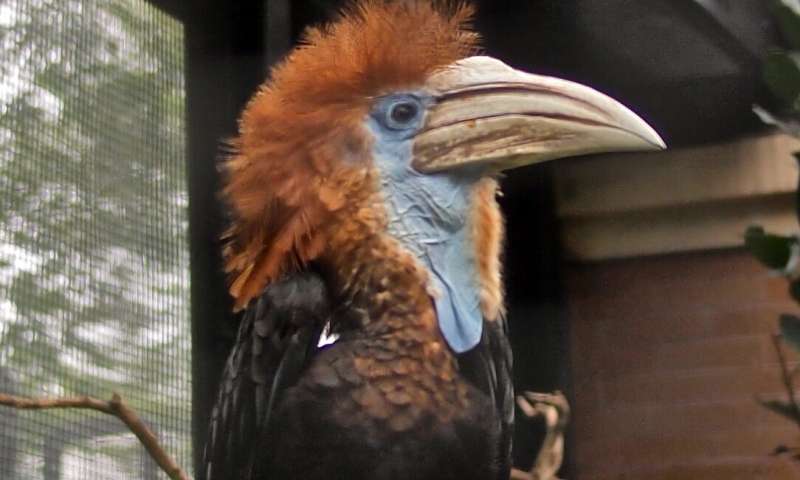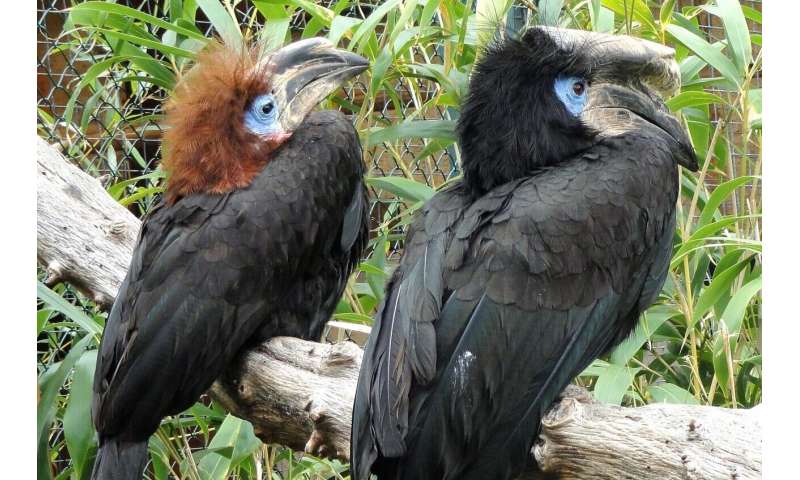August 28, 2024 dialog
This article has been reviewed according to Science X's editorial process and policies. Editors have highlighted the following attributes while ensuring the content's credibility:
fact-checked
peer-reviewed publication
trusted source
written by researcher(s)
proofread
A price on their heads? Implications of international trade for African hornbills in Cameroon

Tropical birds known for their massive bills, hornbills include 32 Asian and 27 African species in the avian family Bucerotidae. Many hornbills have a casque on their upper mandible, which in some species is spectacularly colorful. Many species also share a unique breeding strategy, in which nesting females incubate eggs and raise chicks inside sealed natural tree cavities for up to 100 days, depending entirely on males to bring them food.
Unfortunately, due to both overhunting and habitat destruction, nearly half of all hornbill species are now listed as threatened with extinction by the International Union for Conservation of Nature (IUCN). In addition, many African species still listed as "least concern" by the IUCN have been extirpated from large areas of their historic ranges, such as in Nigeria and Ghana.
Now, African hornbills face a new threat: Commercial demand for their heads in international trade. Cameroonian researcher Francis Guetse brought this problem to our attention after he received reports of hunting targeting hornbills for foreign buyers in Mont Nlonako, Cameroon, the site of an Important Bird Area and proposed wildlife reserve. Together, we decided to investigate, taking into account both online trade in hornbills and interviews with hunters in Cameroon.
Wildlife trade has driven species declines and extinctions around the world and, unfortunately, wild birds comprise a major proportion of sales. Unsustainable hunting and trapping to supply these markets is thus a recognized threat to many bird species, such as African vultures, Asian hornbills, and parrots worldwide, but its consequences for African hornbills have received little attention until now.
We investigated online retailers in order to examine online sales of African hornbill products, and we evaluated hornbill hunting practices in western Cameroon through interviews with residents on hornbill demand, supply, and hunting pressure.
The emergence of online social media platforms has facilitated a rapid expansion of global markets for wildlife products, encompassing both legal and illegal trade. Social media platforms currently provide traders with unprecedented opportunities for traders to access customers, circumventing traditional intermediaries.
In our analysis of online sales, we considered factors including numbers of sales, species conservation status, Convention on International Trade in Endangered Species (CITES) listing, and skull and body size.
-

The White-thighed Hornbill (Bycanistes albotibialis) is one of three species native to Cameroon that accounted for 66% of online trade in hornbills. Credit: Tommy Andriollo, CC BY-SA 4.0, via Wikimedia Commons -

The Yellow-casqued Hornbill (Ceratogymna elata) is one of three species native to Cameroon that accounted for 66% of online trade in hornbills. Credit: Denise Chan, CC BY 2.0, via Wikimedia Commons -

A pair of Black-casqued Hornbills (female at left and male on right) in a zoological garden. Credit: Daderot - Public Domain, via Wikimedia Commons
We found that online hornbill trade includes skulls and other products from five Asian species, all of which were CITES-listed, and 20 African species, representing nearly 75% (20/27) of species on the African continent. Nearly half (9/20) of the African hornbill species we found in online trade were native to Cameroon, of which three species—the Yellow-casqued Hornbill (Ceratogymna elata), Black-casqued Hornbill (C. atrata), and White-thighed Hornbill (Bycanistes albotibialis)—accounted for 66% of hornbill products online.
Approximately 73% of Cameroonian hunters interviewed targeted hornbills, with 91% of these motivated to acquire hornbill heads for trade, almost all of whom reported intending to sell their products to foreign buyers. Hunters indicated that the demand for hornbill heads was driven by Asian demand, with locals understanding the nationality of buyers as Chinese, although confirming the identity of buyers was beyond the scope of our study.
Our investigation also indicated a shift in hunting behavior in Cameroon that can be traced back over a span of two years, with younger hunters targeting hornbills more frequently. Although Cameroon Decree 73/658 legally regulates the carrying of firearms and ammunition, forest law enforcement is weak, and firearms are widely used by hunters in the Mont Nlonako area.
Hunters reported shooting any animal that could be sold, and interviews revealed that many were aware that they were engaged in illegal activity with potential legal consequences. Hunters also reported that hornbill populations appear to have declined over the past two years due to the drastic reduction in their populations and that consequently, they venture into other areas in search of hornbills to hunt.
African hornbills are not typically categorized as luxury products such as elephant ivory, and thus are subject to fewer trade regulations. Our findings highlight the urgent need to address the negative impacts of international wildlife trade and implement measures to protect African hornbill populations from increasing threats of overexploitation.
Conservation action is particularly urgent given that even where hornbill species are fully legally protected, high levels of persecution due to international trade in their casques may drive severe population declines that may push species to the brink of extinction. While online trade in hornbill heads showed little price variation among hornbill species from Cameroon, international demand could lead to the overexploitation of hornbill species due to their visibility and value.
A salient example is the Helmeted Hornbill (Buceros vigil) of southeast Asia, a species whose solid bill and casque commands prices that exceed those of ivory by weight. Although legally protected throughout its range, intense persecution has pushed this species to the brink of extinction, and it is now critically endangered.
Helmeted Hornbills are unique among hornbills in having solid (rather than hollow) casques, and while the hollow casques of other hornbill species are less suitable for carving, their distinctive forms and appearance still attract buyers, placing these species at risk.
To this end, we strongly recommend that African hornbill species be listed on CITES Appendix II, as species which, although currently not threatened with extinction, may become so without trade controls, as well as other species that resemble them.
Currently, many Asian hornbills are listed by CITES while African hornbills are not, which may have resulted in increased trade pressure on African hornbills, such as we have documented in our paper published in Global Ecology and Conservation. We hope that both Cameroonian and international authorities will take these findings into account to support conservation awareness campaigns and law enforcement operations to protect hornbills and other remarkable African wildlife.
Future research priorities include investigating foreign destinations and pathways of hornbill trade from Cameroon and understanding the extent to which local hornbill populations are declining in response to hunting pressure. We also urge that conservation interventions, including awareness campaigns and law enforcement, be accompanied by ongoing efforts to monitor populations of these iconic birds.
This story is part of Science X Dialog, where researchers can report findings from their published research articles. Visit this page for information about Science X Dialog and how to participate.
More information: Shan Su et al, A price on their heads? Assessing foreign demand as a driver of hornbill hunting in Cameroon, Global Ecology and Conservation (2024). DOI: 10.1016/j.gecco.2024.e02905
Journal information: Global Ecology and Conservation
Nico Arcilla and Shan Su work with the International Bird Conservation Partnership (IBCP), whose mission is to foster and support research, outreach, and partnerships to advance the conservation of birds worldwide.



















